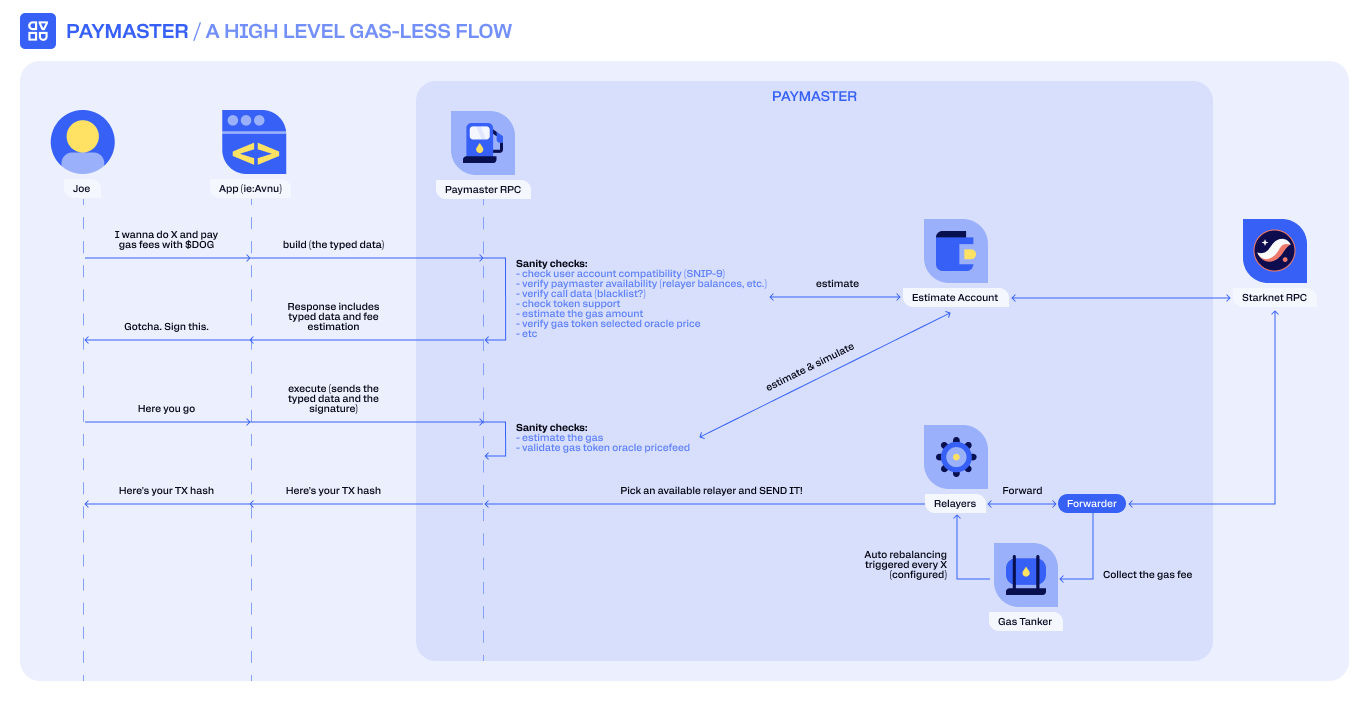Architecture Overview
At a high level, the AVNU Paymaster is composed of a service layer and on-chain contracts. It abstracts gas fees for users by determining how fees are paid. In the case of gas-free transactions, it also determines who sponsors the transaction. Here's how the core components interact:
For the detailed Paymaster API specification defined by SNIP-29, see the official schema:SNIP-29 Paymaster API JSON
is composed of a service layer and on-chain contracts. It abstracts gas fees for users by determining how fees are paid. In the case of gas-free transactions, it also determines who sponsors the transaction. Here's how the core components interact:
Components and Roles
Paymaster Service: The Rust-based backend that handles logic, pricing, authorization, and routing of transactions through relayers.
Forwarder Contract: The central on-chain contract that validates and forwards transactions. It ensures only whitelisted relayers can interact and enforces execution constraints.
Relayer Accounts: These accounts are responsible for submitting & paying for transactions to the blockchain. Each relayer can process one transaction at a time due to nonce handling.
Estimate Account: A specific relayer dedicated to estimating transaction fees. It must maintain a stable nonce, which is why it should not be used for actual execution.
Gas Tank: An account dedicated to receive all users token payment, it will be use to swap tokens back to STRK and refill relayers once a while.
High-Level Flow
This architecture ensures a clear separation of responsibilities, safe nonce management, and the ability to scale horizontally and vertically by managing relayer accounts effectively.

Forwarder
The Forwarder is the core on-chain contract of the AVNU Paymaster. It executes user transactions, collects gas fees, and ensures that only authorized relayers can submit transactions.
✅ Audited by Nethermind - Read the audit & Read the code
Responsibilities
- Executes transactions on behalf of users (gasless & gasfree)
- Restricts access to whitelisted relayers
- Collects gas tokens and routes them to a configurable recipient (The GasTank)
- Emits events for sponsored (gasfree) flows
- Supports ownership and upgradability
How it works
There are two main methods:
- execute(...): For gasless transactions. The user pays in any supported token. Tokens are routed to the gas_fees_recipient.
- execute_sponsored(...): For gasfree/sponsored transactions. No token transfer is done; instead, a SponsoredTransaction event is emitted with custom metadata.
Other functions let you set or get the gas fees recipient(aka Gas Tank), all gated by ownership checks.
Relayers, GasTank & Estimate Accounts
All contracts representing the Relayers, the Gas Tank or the Estimate account are Ready(formerly ArgentX) Contracts - Read the code
Updated 4 months ago